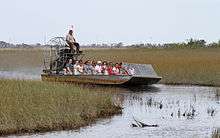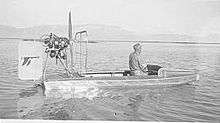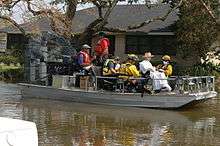Airboat


An airboat is a flat-bottomed vessel (jon boat) propelled in a forward direction by an aircraft-type propeller and powered by either an aircraft or automotive engine.[1] They are commonly used for fishing, bowfishing, hunting, and ecotourism.
Airboats are a very popular means of transportation in marshy and/or shallow areas where a standard inboard or outboard engine with a submerged propeller would be impractical, for example, in the Florida Everglades, parts of the Indian River Lagoon, the Kissimmee and St. Johns Rivers, as well as Louisiana Bayous.
Overview
The characteristic flat-bottomed design of the airboat, in conjunction with the fact that there are no operating parts below the waterline, permit easy navigation through shallow swamps and marshes; in canals, rivers, and lakes; as well as on frozen lakes. This design also makes it ideal for flood and ice rescue operations.
The airboat is pushed forward by the propeller, which produces a rearward column of air behind it. The resulting prop wash averages 150-mile-per-hour (241 km/h). Steering is accomplished by diverting that column of air left or right as it passes across the rudders, which the pilot controls via a "stick" located on the operator's left side. Overall steering and control is a function of water current, wind, water depth, and propeller thrust.
Stopping and reversing direction are dependent upon good operator/pilot/driver skills since airboats do not have brakes. They are incapable of traveling in reverse, unless equipped with a reversible propeller. Some designs use a clam shell reversing device intended for braking or backing up very short distances but these systems are not commonly used.
The operator/pilot/driver, and passengers in most instances, are seated in elevated seats that allow visibility over swamp vegetation. High visibility lets the operator and passengers see floating objects, stumps and animals in the boat's path.
History

The first airboat, called the Ugly Duckling, was built in 1905 in Nova Scotia, Canada by a team led by Dr. Alexander Graham Bell. It was used to test various engines and prop configurations.
Glenn Curtiss, an associate of Dr. Bell, is reported to have registered the first airboat in Florida, United States in 1920. It was called the Curtis Scooter[2] and had a closed cockpit design.

An airboat called a Free Bottom Craft was built in the mid to late 1920s using a wood hull and a Curtiss aircraft engine.[3] It was built by Charles Post and Herbert Ballantine in Huntington, NY; tested on the Long Island's Hewlett Bay; and exhibited at a New York boat show.
By the 1930s homemade airboats began appearing in the swamps and marshes of Florida and Louisiana. One company in Florida claims to have been providing airboat rides as entertainment since the mid-1930s. Over the years a variety of designs were tried and through trial-and-error, the standard design used today arose: an open, flat bottom boat with an engine mounted on the back, the driver sitting in an elevated position, and a cage to protect the propeller from objects flying into them.
One well documented case of a homemade design (though not the first) was an airboat built by staff at the Bear River Bird Refuge near Brigham City, Utah in the 1940s. It appears to have involved collaborative efforts by three employees of the refuge - Leo Young, G. Hortin Jensen and Cecil Williams. A 1987 story in Ducks Unlimited magazine mentioned Young and Jensen and dated the building of the first boat in 1950. Refuge records, however, show the first boat came into use in 1943, with several photos of running air boats dated 1947. Prior to the introduction of the airboat, refuge biologists had to either walk through shallow water and deep, sticky mud or push unpowered flat-bottom boats with long poles. Staff had experimented with a boat called the "Mud Queen," which had small paddle wheels on either side that pushed the boat. They built their first airboat nicknamed "Alligator I" from a flat-bottom boat pushed along by an aircraft engine purchased for $99.50. Young reported that he called the first airboat an "air-thrust boat." Once word got out about the boat, Leo Young built and sold boats all over the world.
Manufacture
Airboat manufacturers tend to be small, family run businesses that assemble built-to-order boats. Airboats are also manufactured in Russia, Australia, Italy and Finland.
Modern, commercially manufactured airboat hulls are made of aluminum or fiberglass. The choice of material is determined by the type of terrain in which the vessel will be operated. Standard hunt/trail boats are 10-foot (3.0 m)-long with a two- to three-passenger capacity. Tour boats can be much larger, accommodating 18 passengers or more.
Engines are either an air-cooled, 4- or 6-cylinder aircraft or water-cooled, large-displacement, V8 automotive engine, ranging from 500 to over 600 horsepower (450 kW). Automotive engines tend to be less expensive due to readily-available replacement parts and less expensive High octane automotive gas. Since an opposed, 4- or 6-cylinder (O4 or O6) aircraft powerplant contains fewer moving parts than a standard automotive engine, it is easier to repair and weighs less. Most reciprocating aircraft powerplants can be derated to burn 87-octane automotive gas instead of more expensive aviation gas.
Most of the sound produced by an airboat comes from the propeller although the engine itself also contributes some noise. Modern airboat designs are significantly quieter thanks to mufflers and multi-blade carbon-fiber propellers.
Safety
Knowledge of operational safety is essential when operating an airboat.
The engine and propeller are enclosed in a protective metal cage that prevents objects, e.g., tree limbs, branches, clothing, beverage containers, passengers, or wildlife, from coming in contact with the whirling propeller, which could cause devastating damage to the vessel and traumatic injury to the operator and passengers. If a tree branch gets into a propeller, the spray of material could be devastating, causing damage to the vessel and injury to the boat's occupants.
In 1998-99 the U. S. Fish & Wildlife Service's National Conservation Training Center, located in Shepherdstown, West Virginia, and in cooperation with the U. S. Corps of Engineers in Jacksonville, Florida, produced a 70-minute training video entitled Airboat Safety - Design-Operation-Maintenance. The video includes an early history of airboats and interviews with two airboat manufacturers in Florida. It was considered to be the only airboat video of its kind when it was made and may still be the only one with the range of airboat subject matter ever produced in the US. Since it was produced by a Federal Agency, it is in the public domain, and is not copyrighted. 500 copies of the video were produced.
Rescue


In recent years, airboats have proven indispensable for flood, shallow water, and ice rescue operations. As a result, they have grown in popularity for public safety uses.
During the flooding of New Orleans following Hurricane Katrina, August 29, 2005, airboats from across the United States rescued thousands of flood victims. Thirty airboats evacuated over 3,000 patients and medical staff from four downtown New Orleans hospitals in less than 36 hours.
Numerous articles have been published in fire-rescue trade journals[4] describing the advantages, capabilities, and benefits of using airboats for water rescue operations, and providing in-depth description of actual water rescue incidents, including the flooding of New Orleans.[5][6][7][8][9][10]
Airboats are also used by U.S. Military, U.S. Coast Guard, and U.S. Border Patrol. During the Vietnam War the Hurricane Aircat airboat was used by the U.S. Special Forces to patrol areas where larger boats could not go.[11] They are also used in Iraq and Texas for border patrol. The Nov/Dec 2007 issue of Airboating Magazine had an article on airboats used in Vietnam and in Iraq and has had numerous articles on airboats used by U.S Coast Guard and other state and county EMS units for rescue of ice fisherman and rescue in floods and after hurricanes.
See also
- Aerosani
- Hovercraft
- Hydrocopter
- Paddle steamer includes comment regarding animal drive ships
- Rotor ship, a same type of ship using a vertical "pipe" to propel the air
Notes
- ↑ In early aviation history the term airboat was applied to seaplanes or flying boats, amphibian aircraft capable of taking off and landing on water surfaces.
- ↑ Dreamers, Schemers and Scalawags By Stuart B. McIver: Chapter 28, Who Invented the Airboat?
- ↑ A story in the Nov/Dec 2009 issue of Airboating Gazette’’
- ↑ such as Fire Engineering and National Fire and Rescue Magazine
- ↑ Rescuing New Orleans - Nov./Dec. 2005
- ↑ The Evacuation of New Orleans, After the Levees Broke - April 2006
- ↑ Rescue on the Chatahoochee - January 2006
- ↑ The Use of Airboats in Ice and Water Rescue Emergencies - March 2004
- ↑ "You Want To Buy A What" - March/April 2004
- ↑ Saving Lives Across America - August 2004
- ↑ p. 51 Rottman, Gordon L. Mobile Strike Forces in Vietnam 1966-70 Osprey Publlishing